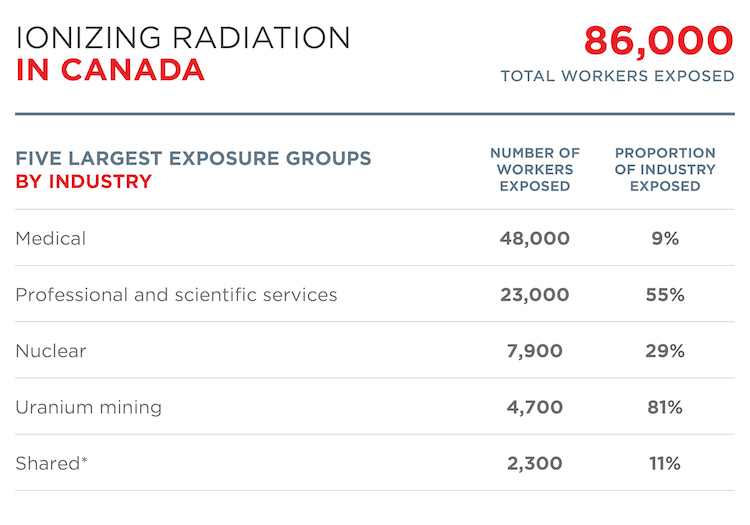Ionizing Radiation Occupational Exposures
Ionizing Radiation Occupational Exposures
Overview
Inhalation, ingestion, wound contamination, and dermal absorption are all potential routes of ionizing radiation exposure.[1] CAREX Canada estimates that 35,000-86,000 Canadians are exposed to ionizing radiation in their workplaces.
READ MORE...
The two largest industrial groups exposed are healthcare, and professional and scientific services industries. In terms of occupation, the largest exposed groups were nurses and aircrew members, followed by ward aids and orderlies.
Occupational exposure to ionizing radiation may also occur in the military, in research laboratories, in other industries using radiography or radioactive materials, and as a result of industrial accidents.[2,3,4] Occupations exposed to natural sources of radiation above typical background levels include uranium, coal, and other underground miners, airline crews, and astronauts.[2,3]
Canadians working in occupations involving exposure to radiation have been monitored by the National Dose Registry (NDR), which is maintained by the Radiation Protection Bureau of Health Canada, since the 1940s.[5] Although exposure levels vary across occupations, the average annual radiation exposure of a monitored Canadian worker is approximately 0.2 mSv.[6]
Prevalence Estimate
Results show 35,000-86,000 workers were occupationally exposed to ionizing radiation in 2016†; 53% of these workers were male. The largest industrial group exposed was medicine‡, where exposure was from the use of ionizing radiation for diagnostic and therapeutic purposes. More women than men were exposed to ionizing radiation in the medical and shared industries while more men were exposed in all other industries listed. On an occupation basis, the largest groups exposed were nurses (27,000), aircrew members (15,000), and ward aids and orderlies (6,800).
†A range of exposure estimates have been calculated. Please refer to the methods for more information. The results on this page that are not presented as a range represent the upper limit of the calculated estimates.
‡Data from the National Dose Registry is not available by industry in the same way as census data, hence industry names here do not match those used in other occupational estimates.
Workers exposed to ionizing radiation by industry in 2016

*Includes workers (e.g. administrators, office staff, and inspectors) who may be exposed across a variety of industry sectors.
Workers exposed to ionizing radiation by region in 2016
Click the second tab to view total number of workers exposed.
Level of Exposure
In total, approximately 86,000 Canadians are exposed to ionizing radiation in their workplaces. The majority of workers exposed to ionizing radiation are in the low exposure category. A substantial number of ionizing radiation-exposed workers are at risk for moderate exposure, but very few are at risk of high exposure.
Workers exposed to ionizing radiation by exposure level in 2016
* <50 workers exposed
Level of exposure by industry
Identifying industries with either 1) workers exposed to high levels of ionizing radiation or 2) a larger number of workers exposed to ionizing radiation is important in guiding cancer prevention efforts to prioritize exposed groups and target resources most effectively.
The figure below shows the number of workers exposed by industry group and level of exposure to ionizing radiation. These results highlight industries with the most number of workers (e.g. medicine), as well as industries with the highest levels of exposure (e.g. nuclear power). Data for all industries captured by the NDR are shown.
Workers exposed to ionizing radiation by exposure level and industry in 2016
*Includes workers (e.g. administrators, office staff, and inspectors) who may be exposed across a variety of sectors.
Methods and Data
Our Occupational Approach page outlines the general approach used to calculate prevalence and exposure level estimates for workplace exposures.
Data Sources
The 2016 National Dose Registry (NDR) survey data were used in developing the occupational estimates for ionizing radiation. The survey contains ionizing radiation exposure monitoring data for over 158,000 Canadian workers collected in 2016 and the results are available in a NDR annual report published in 2018.
Prevalence Estimate Method
CAREX defines exposure to ionizing radiation as having an annual ionizing radiation dose of > 0 mSv (millisievert) in the 2016 NDR survey.
To calculate the lower estimate of the total number of exposed workers in Canada, the number of workers with a measured dose of > 0 mSv in the 2016 NDR survey was totaled. Exposure in different industries was calculated by counting the total number of exposed workers in different job categories in the survey. The exposure proportion in each industry/occupation was calculated by dividing the number of exposed workers by the total number of workers reported, for each job category. A custom tabulation summarizing exposure by province and industry was requested to estimate exposure by province.
To calculate the upper estimate of exposure, we compared NDR data to the 2016 Census of Population. Where job titles in the NDR report did not directly match with the Census descriptions, we assumed that the NDR was monitoring the exposed workforce. Where the job titles did match but the number of workers was different, we applied the NDR proportion exposed values (by level of exposure) to the total number of workers in that job (obtained from the census or from other surveys, if more specific labour force values could be obtained; e.g. CMA’s estimates of the number of gynecologists) to obtain the total number of workers potentially exposed by job category and level of exposure. The exposure proportion in each occupation/industry was calculated by dividing the number of exposed workers by the total number of workers (obtained from the NDR, Census of Population, or other relevant surveys), for each job category. To estimate exposure by province – we applied the distribution of workers in a given occupation by province to the total number of exposed workers in the same occupation.
Exposure Level Method
Workers were assigned to exposure level categories using data on the distribution of workers per dose range, obtained from the 2016 NDR survey. Exposure level categories were defined as follows:
Category 1: Low Exposure
- A group of workers (people in the same job category and industry) is put in this exposure category if workers were exposed to levels ranging from 0-1 mSv.
Category 2: Moderate Exposure
- A group of workers is put in this exposure category if they were exposed to levels ranging from 1-20 mSv.
Category 3: High Exposure
- A group of workers is put in this exposure category if they were exposed to levels greater than 20 mSv.
Sources
Subscribe to our newsletters
The CAREX Canada team offers two regular newsletters: the biannual e-Bulletin summarizing information on upcoming webinars, new publications, and updates to estimates and tools; and the monthly Carcinogens in the News, a digest of media articles, government reports, and academic literature related to the carcinogens we’ve classified as important for surveillance in Canada. Sign up for one or both of these newsletters below.
CAREX Canada
School of Population and Public Health
University of British Columbia
Vancouver Campus
370A - 2206 East Mall
Vancouver, BC V6T 1Z3
CANADA
As a national organization, our work extends across borders into many Indigenous lands throughout Canada. We gratefully acknowledge that our host institution, the University of British Columbia Point Grey campus, is located on the traditional, ancestral, and unceded territories of the xʷməθkʷəy̓əm (Musqueam) people.



